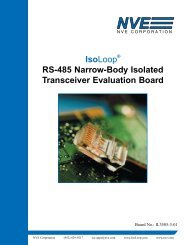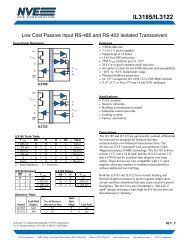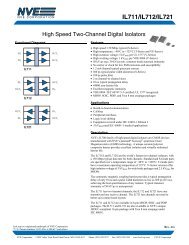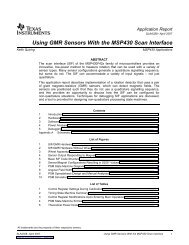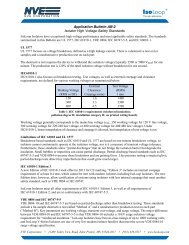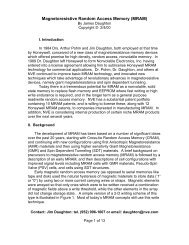very dense magnetic sensor arrays for precision ... - NVE Corporation
very dense magnetic sensor arrays for precision ... - NVE Corporation
very dense magnetic sensor arrays for precision ... - NVE Corporation
You also want an ePaper? Increase the reach of your titles
YUMPU automatically turns print PDFs into web optimized ePapers that Google loves.
The size of the coil is related to the resolutionnecessary to detect the defects. For large defects and <strong>for</strong>deep defects, large coils surrounding the <strong>sensor</strong> arerequired. To resolve small defects, small coils located closeto the specimen are necessary. It is possible to incorporatethe excitation coils directly on GMR or SDT <strong>sensor</strong>s.Eddy currents shield the interior of the conductingmaterial with the skin depth related to the conductivity andthe frequency. There<strong>for</strong>e, by changing the frequency,differing depths of the material can be probed. GMR orSDT <strong>sensor</strong>s with their wide frequency response from dcinto the multi-megahertz range are well suited to thisapplication. The small size of a GMR sensing elementincreases the resolution of defect location if the detector israster scanned over the surface.A prototype of an SDT based eddy current probe hasbeen built and successfully tested <strong>for</strong> detecting cracks ofcalibrated width and depth. Figure 13 shows the output ofsuch a probe. The asymmetry in the <strong>magnetic</strong> field isdetected on either side of the crack when the sensitive axisis perpendicular to the crack. In the left figure, theasymmetry is detected at the ends of the crack when thesensitive axis is parallel to the crack. It has beendemonstrated that the unidirectional sensitivity of GMR<strong>sensor</strong>s enable the detection of cracks at, and perpendicularto, the edge of a specimen. This discrimination is possiblebecause the sensitive axis of the GMR <strong>sensor</strong> can be rotatedto be parallel to the edge; consequently, the signal is dueonly to the crack. With inductive probes, the edge willproduce a large signal that can mask the signal produced bya crack. This capability represents a <strong>very</strong> simple solution toa difficult problem encountered in the aircraft industry --detecting cracks that initiate at the edge of turbine disks ornear the rivets.output(V)x (mm)y (mm)output(V)x (mm)y (mm)Figure 13. The output of an SDT eddy-current probe with20 kHz excitation scanned over a 15 mm by 2 mm deepcrack. a) sensitive axis parallel to the crack. b)sensitive axis perpendicular to the crack. (Resultscourtesy of Albany Instruments.)SDT <strong>sensor</strong>s are in attractive <strong>for</strong> NDE low frequencyapplications, such as <strong>for</strong> the detection of deeply buriedflaws. In contrast, inductive probes have poor sensitivity atlow frequencies because they are sensitive to the timederivative of the <strong>magnetic</strong> field rather than to themagnitude of the <strong>magnetic</strong> field created by the flaw. Fordetecting deep cracks, it is necessary to use large diameterexcitation coils in order to increase the penetration depth ofthe eddy currents into the material under test. SDT eddycurrent probes were tested <strong>for</strong> detecting edge cracks at thebottom of both a single plate and a stack of thick aluminumplates. A short edge crack of 3 mm length and 3 mm heightwas detected at a depth of 18 mm below surface, and acrack of 15 mm length and 3 mm height was detected at 23mm at the bottom of a two-layer aluminum structure.Figure 13 shows the results of a single scan along the edgeand across the buried crack in both magnitude and phaserepresentations.Output (V) (mV)80706050400 20 40 60Displacement (mm)Phase (deg)16012080400 20 40 60Displacement (mm)Figure 14. The signature of a 15 mm long edge crack 9 mmbelow the surface in both magnitude and phase of theoutput of an SDT eddy-current probe. Excitingfrequency was 200 Hz. (Results courtesy of AlbanyInstruments.)Aging aircraft must be inspected <strong>for</strong> defects thataccumulate in the skin including cracks around rivet holesand corrosion between layers in multi-layer airframe skins.Eddy-current probes are of primary use <strong>for</strong> thisnondestructive evaluation. For deep flaws, the lowfrequency response of GMR and SDT <strong>sensor</strong>s make themideal <strong>for</strong> this application. A demonstration of thecapabilities of GMR-based eddy-current probes was carriedout at Albany Instruments. For this experiment, pinholes ofsmall diameters (1.0 and 0.75 mm) of different depth weredetected on the backside of an aluminum plate of thickness1.6 mm. Two rows of holes were machined in the bottomsurface of the plate to simulate corrosion-type defects. Thefirst row consisted of four holes of 1 mm (0.04 inch)diameter, the second one of four holes of 0.75 mm diameter(0.03 inch). The depths of the holes in each row were 1mm, 0.75 mm, 0.5 mm and 0.25 mm. The space betweenholes in each row was 15 mm.The goal of the experiment was to detect these defectsfrom the opposite side of the plate. To obtain thepenetration depth and the resolution required <strong>for</strong> this typeof defects, an excitation coil of mean diameter of about 2mm was chosen. The optimum detection of defects wasobtained at the frequency of 8 kHz. A schematic diagramof the probe above the specimen during the experiment isrepresented in Figure 15.7





